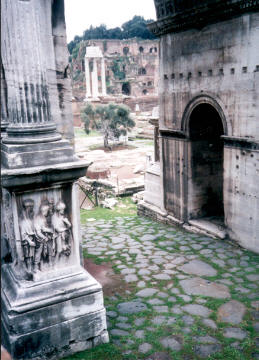 Contents -
Previous Article -
Next Article
Contents -
Previous Article -
Next Article
Concrete was used in the construction of the Arch of Septimius Severus in Rome, seen in the image at left. The appearance of this monument is much like that of those seen in modern cities today.
-- Photo by J. A. Geary.
Most modern people think of concrete as a modern invention. In fact, "Cities of glass and concrete" is a saying that is often used to describe our modern cities. The cliche is often used as a metaphor for the fast paced, mass produced, somewhat artificial nature of the modern life we lead. It would surprise most people to learn that the ancient Egyptians used concrete in the construction of buildings, and the Romans had refined the art of concrete making down to a precise technology. They didn't understand that concrete gained its strength by actually incorporating water into the molecules of artificial limestone as modern chemistry has told us, but they did know that water actually makes the concrete stronger.
The formula for making concrete has been known since the tiem of ancient Egypt and Mesopotamia. Limestone was roasted until all of the water locked within its molecules was driven off and it became powdered lime. The lime was mixed with sand to make mortar for bricls, and with sand and gravel to make the familiar gray concrete that is as much a part of our cities today as it was in the days of the Romans.
The Romans did discover one extra ingredient to add to their concrete that gave it the durability to last through twenty centuries of rain, wind, freezing temperatures, and even the scouring action of sand in a fast moving river current. Pozzolana, a fine grained volcanic sand, was very hard and could resist wear and abrasion better than the soft lime which bound the pieces of gravel together in regular concete made only of lime, sand, and gravel. The Romans soon learned to make their bridge piers from pozzolana concrete to keep the sand borne by river currents from eroding away the foundations of their bridges below the water. Today, modern industrial chemists use silica from blast furnace slag to replace the pozzolana used by the Romans when making portland cement used in construction but many bridges and other structures made with pozzolana concrete by the Romans are still in daily use.
Go to next article:
Go back to previous article: